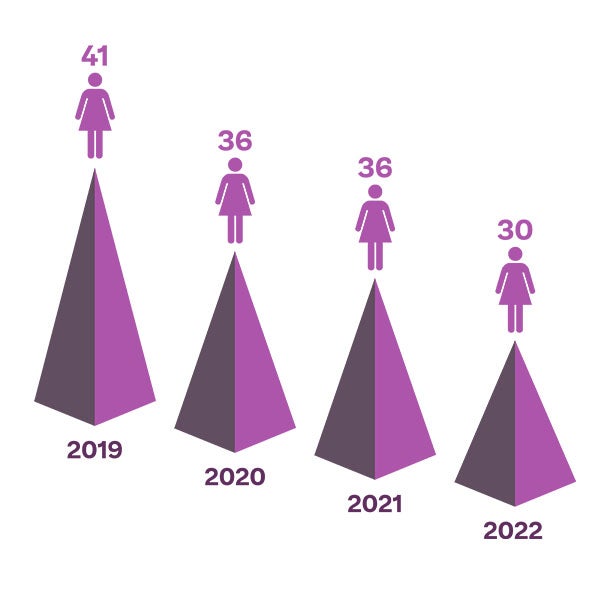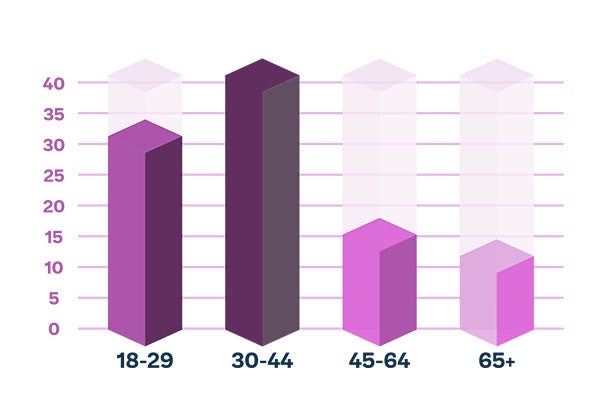 Violencia de género en Paraguay
Violencia de género en Paraguay
For example, Google Trends shows that search interest in the term "femicide" began to rise in the Spanish-speaking world in 2015, reaching its peak when the COVID-19 pandemic began in 2020. Up to October 2022, Paraguay was among the countries whose residents demonstrated the most interest in the subject (with a search index of 60), behind only Bolivia (100) and Peru (68).
"Femicide" search trends - Interest over time

Consistent with this trend, Paraguay did not recognize femicide as an autonomous criminal act until 2016, through Law No. 5777/16 for the comprehensive protection of women against all forms of violence. This law (Article 31) also created the Women’s Observatory, an agency of the Ministry of Women, whose purpose is to monitor and conduct research on violence against women.
A femicide every 10 days in Paraguay
Between 2019 and 2022, 143 women suffered violent deaths for reasons of gender in Paraguay, an average of 36 cases annually, or 1 femicide every 10 days . Thirty cases of femicide were reported between January and September 2022, 6 more than in the same period last year.
Number of femicide cases, 2019-2022

No geographical limits
Observatory information reveals that femicide knows no geographical limits. Both the capital, Asunción, and 16 of the country's 17 departments reported at least one case of femicide between 2019 and 2022. Four out of ten cases occurred in the most populous departments, Central (29%) and Alto Paraná (12%). Within Central, half of the femicides occurred in Capiatá (23%), Limpio (16%) and Luque (13%).
Number of femicide cases by department, 2019-2022

Characteristics of femicide in Paraguay
Femicide in Paraguay is young and extremely violent.
The victims of these crimes committed between 2019 and 2022 range from children under 1 year of age to 69-year-old women. Seventy-six percent of victims were between ages 18 and 44, the peak of their productive and reproductive years. Perpetrators were 37 years old, on average, while the majority were also between ages 18 and 44.
Age of victims

Age of perpetrators

The mechanisms used by perpetrators are knives (40.6%) or firearms (35.0%).

Source: Women's Observatory in Paraguay
Femicides are usually perpetrated by someone known to the victim
Observatory data also provide contextual information. Ninety-four percent of perpetrators were known to the murdered women and were most often their partners or ex-partners (86%) . Nearly 5% of the perpetrators were close relatives (sibling, child, etc.), 3.5%, friends or acquaintances, and 5.6%, strangers.
Percentage of perpetrators and their relationship with victims

Source: Women's Observatory in Paraguay
Most victims were mothers
An overwhelming percentage of victims (79%) were mothers with two children, on average. From 2019 to 2022, the majority of orphans were minors. This past year, all feminicide victims had at least one child, and of the 63 orphans, 40 (63%) are children.
The importance of data
The reality of femicide in Paraguay is visualized with reliable data compiled and verified through inter-institutional articulation. However, it is essential to improve data capture by supporting and building the capacity of institutions working on gender-based violence, such as the Women's Observatory.
Among other characteristics, records should include identification variables of both victims and perpetrators (including sex, age, relationship, education, occupation), as well as the methods and context of the homicides.
How do these data help combat femicide?
Through three key mechanisms:
- Visibility. It is necessary to encourage dialogue about femicide and its devastating consequences. Making the problem visible through data helps increase social awareness of the importance of protecting the life of all women.
- Prevention. A society that has a data-based understanding of the problem of femicide is an alert society that acts accordingly, demanding more and better mechanisms for women’s protection.
- Policymaking. Using data as evidence to inform decision-making is the best way to formulate more fiscally efficient, technically appropriate and socially accepted policies.
Above all, efforts to eradicate femicide require a firm and lasting commitment to the continuous, crosscutting reduction of historical gender inequalities.






Join the Conversation